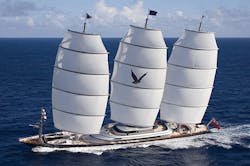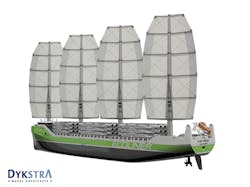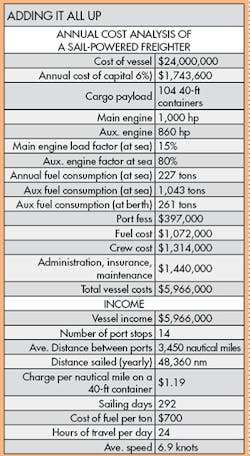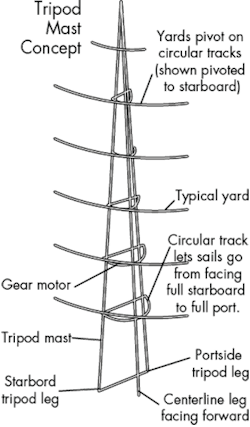Updating the Sailing Cargo Ship
Global transportation networks rely almost exclusively on fossil fuels, and of all those networks, marine shipping is considered the biggest polluter. Much of the pollution generated by freighters and cargo ships is at sea and out of the public eye. Still, the estimated 90,000 vessels traveling the world’s shipping lanes daily burn 7.3 million barrels of heavy bunker oil with 3.5% sulfur content. Over a year, this releases approximately 20 million tons of sulfur oxides (SOX) into the atmosphere. To put this into perspective, the world’s 760 million or so cars annually emit 78,600 tons of SOX.
Since the early 1970's when technology offered economic alternatives to fossil fuels, the price for these fuels dropped, thereby removing the cost incentive to develop alternatives. Today, the concerns for human health, the environment, and the climate are being used to push for alternatives. For example, in 2007, James Corbett, a professor at the University of Delaware’s School of Marine Science and Policy estimated that marine pollution annually contributes to approximately 84,000 deaths. If the world’s shipping fleet were a country, it would be the sixth leading emitter of greenhouse gases. These figures do not include larger vessels currently being built.
Because of the pressures for marine engineers to include alternatives to fossil fuels, there has been renewed interest in reviving large commercial sailing vessels.
The Push for Wind
Among the organizations promoting wind-powered freighters is the recently established International Windship Assoc. (IWSA). Some of this London –based organization’s founding members include B9 Shipping, Fair Winds Trading Company, Propelwind, and Norsepower.
The IWSA recently put together a study of a proposed commercial sailing vessel, the Fairtransport Ecoliner, a four-masted cargo ship carrying 43,060-ft2 of sail. The ship would use trade winds and ocean current to get the same average port-to-port cruising times as oil-burning ships. Designers included Dykstra Naval Architects and the Rotterdam Naval College with some funding from the Wolfson Foundation of UK.
The Ecoliner is a fine design, but a smaller wind-powered cargo ship is more likely to be built. After all, when developing a new class of vessel such as this, it is better to start smaller because funding may be easier to obtain, giving designers a better chance of actually getting to the building phase.
This file type includes high resolution graphics and schematics when applicable.
Examining the Numbers
Design-and-build projects must make economic sense, so let’s look at some numbers on small freighters. About 90% of the world’s non-bulk shipping is carried in container vessels, and one of most common is the Type 151 motor vessel. These relatively smaller freighters widely serve as feeder vessels, moving goods among smaller ports and ultimately feeding major trunk routes serviced by larger ships. Smaller commercial sailing vessels would make excellent feeder vessels to carry goods on routes with several port stops. On each leg of such a trip, the ship would be loaded with goods specific to the needs of the next port.
Now consider the income the industry earns on shipping containers. If the route is used to ship machinery from Taiwan to Los Angles, the ship can charge about $3,560 to $4,000 per 40-ft container for delivery over this route. Our proposed sailing freighter carries 104 containers, 52 in the hull and 52 on deck. If this vessel were fully-loaded, it would earn about $391,000 per trip. Assuming a shipping firm can sustain a minimum of six such trips per year, it will earn $2.35 million per year, or $11.8 million over five years with a ship of capacity.
Wind conditions along trade-wind sailing routes are fairly reliable, so the biggest variable in the time it takes to complete an entire route are port turn-around times. Smaller vessels have shorter port turn-arounds than giant container ships and are back at sea sooner. This partially makes up for the smaller ships’ slower travel rates.
Updating the Cargo Ship
The use of modern materials and design techniques to update earlier concepts is a major driver in the revival of commercial sail. For example, one design breakthrough was the combination of rotating carbon-fiber masts and practically robotic sails. They were both used on the steel-hulled Maltese Falcon, a ship built in 2006 that can be sailed by a single person. The sails and masts on this full-rigged yacht follow the Dynaship concept invented in the 1960's by German hydraulic engineer Wilhelm Pröiss.
This sailing rig is also the same general concept used in the Ecoliner and for our proposed ship’s three masts. But we combined it with a centuries-old idea developed by the Polynesians: the tripod mast. Carbon-fiber masts that rotate would be too costly for a commercial vessel. And unloading containers near large rotating masts would expose delicate mechanisms to damage.
The movable parts of the masts are light, strong carbon-fiber yard arms which carry the sails. They reduce weight aloft yet withstand large deflections during wind gusts without breaking. Carbon fiber’s strength and stiffness eliminates the sheets and braces, that is, the lines running from the ends of the old style yard arms down to the deck on traditional sailing ships.
The yard arms mount to circular tracks so motors can rotate them about the mast. Wind sensors at various heights tune each motorized yard arm to the proper angle for the sails to best catch the wind. This is important because wind direction can vary over the height of a tall mast. The overall design also lets one crew member handle the entire ship. Traditional sailing ships required a dozen hands per mast to trim the yards.
Each sail is made of conventional Dacron sail cloth. Strong wire rope sewn into the outboard edges (or leeches) helps the sails resist movement of the yards and prevents them from tearing under high loads.
One major difference between the Maltese Falcon’s mast and ours is that the Maltese Falcon‘s has a C-shaped section hollowed out along its forward side that runs it length. It is used to house the furled sails.
Each sail attaches to small motorized shuttles running along its upper and lower yard arms. The shuttles move in unison to pull the sails toward (furling) or away (unfurling) from the mast, much like a motorized window curtain on a track. When the sails are furled or stowed, they are tucked into the hollow section of the mast. However this design greatly reduces the strength of the mast which led to the requirement of using carbon fiber for Maltese Falcon’s masts.
The sails on our three-masted design are also furled and unfurled horizontally by motorized shuttles. But there is no storage area inside the mast. Instead, when they are furled, they are exposed to the sun and weather. To protect them, sacrificial sun-screen Acrylic panels are sewn over the leeches of each sail. These panels are the last portion of the sails pulled in and are left exposed, thereby protecting the Dacron underneath.
Problems left to solve
A preliminary study of any design project determines the possible problems designers may encounter during design, and our study has uncovered several. For example, even with a tripod steel mast, the side-to-side (or thwartship) loads it places on the hull and deck are large. Finite element analysis must be used to verify the design integrity of the hull and its ability to resist loads from wind pressure on the sails superimposed over hull-twisting loads due to wave action.
Another set of problems is that the deck of sailing ships must have large hatch openings for loading and unloading containers into the hull below decks. This weakens the hull right where strength is needed the most. Another potential problem is the tripod mast blocks easy loading and unloading of some containers stored on deck.
These obstacles call for developing ways to shift containers fore and aft to aid in loading/unloading. Adding a mast-mounted crane as in the Ecoliner is one solution. Another possible solution is to install deck railways to help shift cargo.
For those steering and commanding a sailing ship, visibility of the sails and workings of the ship is critical. The Ecoliner concept, for example, has a forward-mounted bridge that gives the crew a good view forward but not at the masts and sails behind it. However, on large sailing ships, someone should be constantly monitoring the sails. Like most sailing vessels, our design places the bridge toward the rear where it is easier to see the workings of the ship. Remote sensors on the masts would help monitor the sails and equipment, but most sailors are taught not to rely solely on electronics that can fail at sea.
Marine designers who study past designs of sailing vessels note that the older designs carried much more sail area than vessels designed today. One reason for this is the crews of that time knew how to handle large sailing vessels. So the knowledge base required to handle large sailing vessels at the grassroots crew level will have to be rebuilt for commercial sail to come back.
The Cost of Going Big |
|
This is a period of rapid change in the marine transportation industry. The current economics of marine construction favors large vessels such as the 1,312-ft long Maersk Triple-E cargo carriers. The Triple-E stands for "Economy of scale, Energy efficient, and Environmentally improved". The economy of scale is certainly true if one does not include a cost penalty for pollution. This vessel costs $185 million to build compared to an estimated $24 million for our proposed sailing vessel. The cargo capacity of the Triple E is 9,170 40-foot containers. The energy efficiency largely comes from slowing the vessel's cruising speed to 19 knots. This is getting close to a sailing vessel's speed of 12 to 15 knots in trade wind conditions. The environmental improvement will be a technological challenge. After all, this vessel will have two oil-burning 43,000 hp engines. In comparison, a Neo Panamax ship built to pass through the Panama locks, if they get widened, will carry 6,000 40-foot containers with one 96,875-hp engine. Annual fuel cost for the ship is about $86 million, assuming 292 days at sea and 73 at berth. The estimated fuel burn rate is 415 tons per day at sea and 22.3 tons per day at berth. These calculations would be close to those for the Maersk vessels. Fuel costs for our 1,000-hp sailing vessel would be less than 1% of that figure. Maersk is building 20 Triple-E vessels at Daewoo shipbuilding. The effect of adding the pollution of these giants on the environment could be staggering. Included in the pollution figure should be the emissions from the freight trucks serving the few ports that can handle and unload such large ships. The US Navy has safely used nuclear power in ships for years and it should be explored as an alternative to fossil fuels for such large ships. There are some efforts to curb the growth of marine pollution. Effective 2015, ships in American, Canadian, and European coastal waters, as well as those in the U.S Caribbean Sea, waters must fuels with a sulfur content of 0.1% or less, which is a drop from the previous limit of 1%. This fuel costs 60 to 300% more than current bunker fuel. Vessels motoring in unrestricted waters can still burn fuels with 3.5% Sox. A commercial sailing vessel with a small main engine would burn a fraction of what current vessels do. Delivery of goods over a wider area with feeder vessels would also shift truck traffic to less polluting marine traffic. Most fuel consumed would be for onboard generators, and only if the ship carried refrigerated containers. All this makes a good environmental and economic support for building commercial sailing vessels to meet our transport demands. |
This file type includes high resolution graphics and schematics when applicable.







